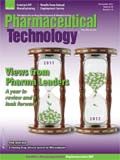Supporting Innovation Requires Consistency and Vision
Political leaders need to consider the impact of the biopharmaceutical industry on the economy.
American policymakers of all stripes are talking a lot about the importance of innovation to jumpstarting job growth and regaining economic momentum. In September, for example, President Obama signed a new patent reform bill into law, saying: "If we're going to create jobs now and into the future, we're going to have to out-build, out-educate and out-innovate every country on earth."

John Castellani
Many of Obama's political opponents also talk about the importance of innovation and entrepreneurship as a key to short-term economic recovery and long-term economic health. As a result, a sort of broad bipartisan agreement about the importance of innovation to our future has emerged. It is time to embrace this common ground and find actionable, meaningful, and consistent ways to support innovation.
The Administration and policymakers need to focus on stimulating and growing existing innovative American industries. Look no further than America's biopharmaceutical research sector to find a dynamic, technology-driven industry. A recent report on employment in the sector by the Battelle Technology Partnership Practice postulated that an "ideal" industry for stimulating US economic growth would: have the ability to grow and increase output in tough economic times; provide high-wage, good quality jobs; be innovative and deploy the latest technology to generate competitive advantages for US companies; generate significant exports; create a strong supply-chain that drives further economic growth; encourage capital flow with sustained growth; and be profitable and provide funds for reinvestment into the R&D cycle.
Battelle concluded that the biopharmaceutical research sector has all of these characteristics, "and more." In fact, the sector already makes an enormous contribution to the national, state, and local economies. According to Battelle, biopharmaceutical research companies supported more than four million jobs nationwide as of 2009, including nearly 675,000 direct industry jobs. The report showed that each direct sector job supported nearly five additional indirect and induced jobs nationwide. The jobs created were broad-based and touched a wide variety of businesses and skill levels.
Based on this sector's performance, it is both perplexing and frustrating to hear President Obama and others from across the political spectrum talk glowingly about innovation and innovative industries. The problem is that there has been little follow-up or a horizontal and long-term strategy designed to support their stated goal. When talking about deficit reduction and efforts to control spiraling healthcare costs, President Obama and some in Congress have pushed for policies that could actually discourage biopharmaceutical R&D and innovation.
Consistency and perspective are lacking. Too many policymakers often see the cost of medicines, in particular, as part of the equation for solving immediate fiscal challenges. But they fail to recognize the long-term value of innovative medicines as a means of helping to control healthcare costs over the long term. As a result, they often pursue policies that undermine needed incentives for doing innovative medical R&D. Policies, in other words, that may be detrimental to both patients and for our economy in the short- and long-term.
For much of the past 50 years, America has been at the heart of a biopharmaceutical revolution. Our companies continue to lead the world both in investing in new medical R&D as well as in developing new drugs. The resulting life-saving medicines and innovative healthcare technologies have contributed enormously to the fight against disease as well as efforts to promote health and extend life.
The value of medical innovation for patients and our economy is increasingly well documented. How to fully realize the promise of innovative medicines—to improve healthcare outcomes and quality and control healthcare costs—remains a fundamental challenge.
Today, America's biopharmaceutical research companies grapple with more complex science, an evolving business model, and an often unpredictable regulatory environment. To continue thriving, it is essential for policymakers to take a larger, more integrated view of the role that innovative medicines play in securing quality and affordable healthcare for patients. A consistent, horizontal fabric of policies that foster medical innovation will go far towards securing a healthier as well as more economically competitive America.
John Castellani is president and CEO of the Pharmaceutical Research and Manufacturers of America (PhRMA).

Pharmaceutical Tariffs Are Imminent: How Industry is Bracing for Impact
April 16th 2025On April 14, 2025, the Trump Administration launched a national security-driven investigation into pharmaceuticals, a move that will likely result in tariffs being placed on pharmaceutical drugs, ingredients, and other components that are imported from outside of the United States.